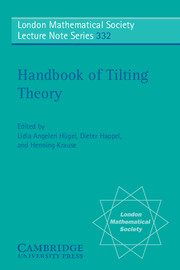Book contents
- Frontmatter
- Contents
- 1 Introduction
- 2 Basic results of classical tilting theory
- 3 Classification of representation-finite algebras and their modules
- 4 A spectral sequence analysis of classical tilting functors
- 5 Derived categories and tilting
- 6 Hereditary categories
- 7 Fourier-Mukai transforms
- 8 Tilting theory and homologically finite subcategories with applications to quasihereditary algebras
- 9 Tilting modules for algebraic groups and finite dimensional algebras
- 10 Combinatorial aspects of the set of tilting modules
- 11 Infinite dimensional tilting modules and cotorsion pairs
- 12 Infinite dimensional tilting modules over finite dimensional algebras
- 13 Cotilting dualities
- 14 Representations of finite groups and tilting
- 15 Morita theory in stable homotopy theory
- Appendix: Some remarks concerning tilting modules and tilted algebras. Origin. Relevance. Future.
Appendix: Some remarks concerning tilting modules and tilted algebras. Origin. Relevance. Future.
Published online by Cambridge University Press: 25 May 2010
- Frontmatter
- Contents
- 1 Introduction
- 2 Basic results of classical tilting theory
- 3 Classification of representation-finite algebras and their modules
- 4 A spectral sequence analysis of classical tilting functors
- 5 Derived categories and tilting
- 6 Hereditary categories
- 7 Fourier-Mukai transforms
- 8 Tilting theory and homologically finite subcategories with applications to quasihereditary algebras
- 9 Tilting modules for algebraic groups and finite dimensional algebras
- 10 Combinatorial aspects of the set of tilting modules
- 11 Infinite dimensional tilting modules and cotorsion pairs
- 12 Infinite dimensional tilting modules over finite dimensional algebras
- 13 Cotilting dualities
- 14 Representations of finite groups and tilting
- 15 Morita theory in stable homotopy theory
- Appendix: Some remarks concerning tilting modules and tilted algebras. Origin. Relevance. Future.
Summary
The project to produce a Handbook of Tilting Theory was discussed during the Fraueninsel Conference 20 Years of Tilting Theory, in November 2002. A need was felt to make available surveys on the basic properties of tilting modules, tilting complexes and tilting functors, to collect outlines of the relationship to similar constructions in algebra and geometry, as well as reports on the growing number of generalizations. At the time the Handbook was conceived, there was a general consensus about the overall frame of tilting theory, with the tilted algebra as the core, surrounded by a lot of additional considerations and with many applications in algebra and geometry. One was still looking forward to further generalizations (say something like “pre-semi-tilting procedures for near-rings“), but the core of tilting theory seemed to be in a final shape. The Handbook was supposed to provide a full account of the theory as it was known at that time. The editors of this Handbook have to be highly praised for what they have achieved. But the omissions which were necessary in order to bound the size of the volume clearly indicate that there should be a second volume.
Part 1 will provide an outline of this core of tilting theory. Part 2 will then be devoted to topics where tilting modules and tilted algebras have sown to be relevant.
- Type
- Chapter
- Information
- Handbook of Tilting Theory , pp. 413 - 472Publisher: Cambridge University PressPrint publication year: 2007
- 15
- Cited by



